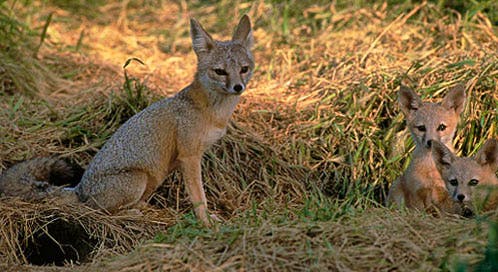The Panoche Valley is a unique California treasure – and one that should be protected. Located 30 miles south of Los Banos and 60 miles west of Fresno, the Panoche Valley represents a lost landscape in California’s busy and fragmented Central Valley and surrounding foothills – a bucolic valley of open grasslands dotted with small ranches and family-owned organic farms. This area is a landscape lush with a diversity of wildlife found nowhere else.

Giant kangaroo rat, © George Harrison/USFWS
The U.S. Fish and Wildlife Service has identified the Panoche Valley as one of only three core areas left in California necessary for the survival and recovery of the highly endangered San Joaquin kit fox, the endangered blunt-nosed leopard lizard, and the endangered giant kangaroo rat. Though they are now missing from most of their former range, these three native species can be found living in relatively healthy populations in the Panoche Valley. In fact, of the three core recovery areas for these endangered species, the Panoche Valley is the only one remaining largely intact. The other two core recovery areas (the Carrizo Plain and Western Kern) have been impacted by energy development. On top of that, both those areas are expected to become less hospitable for these species due to climate change impacts. There is no other habitat left for these species. The Panoche Valley is it.
The Panoche Valley is also a globally recognized Audubon Important Bird Area and a refuge for many other rare species, including: mountain plover, burrowing owl, short-eared owl, long-eared owl, golden eagle, ferruginous hawk, loggerhead shrike, grasshopper sparrow, tricolored blackbird, Northern harrier, Swainson’s hawk, white-tailed kite, Oregon vesper sparrow, and more. Birdwatchers come from around the world to the Panoche Valley to spy this dizzying array of raptors and other rare birds. And the variety of life here isn’t limited to the skies. Panoche is home to many rare animals, including the short-nosed kangaroo rat, San Joaquin pocket mouse, Tulare grasshopper mouse, tiger salamander, vernal pools, fairy shrimp and a number of rare plants.

Female blunt-nosed leopard lizard, © Gavin O’Leary/CDFW
Unfortunately, all of these species are facing an immense threat. The Panoche Solar Farm, a 339 mega-watt solar photovoltaic energy facility, would destroy 2,506 acres (3 square miles) in the heart of the Panoche Valley.
This week, Defenders of Wildlife joined with the Sierra Club and Santa Clara Valley Audubon Society to file a lawsuit in state court to stop the Panoche Solar Farm, which is owned in part by the one of the largest investor-owned utilities in the country, Consolidated Edison (also known as Con Edison).
I’d like to emphasize here that Defenders and our partners continue to fight the effects of climate change in our work. Our changing climate is one of the greatest threats of our time, to humans and wildlife alike. However, in order for renewable energy projects to be truly green, we need to make sure they happen in the right places. Defenders has been working for nearly a decade to identify areas for renewable energy development that will not jeopardize the existence of wildlife we are working so hard to protect.
As we have been pointing out to the project developer for several years, there are better places for this project to go. Since 2010, Defenders has made clear to the developer many times that we are opposed to any size project in the Panoche Valley. We have also suggested other locations for this project in areas with fewer impacts on wildlife, including the Westlands Water District. These heavily damaged and water-deficient former agricultural lands are located just over the hills to the east and hold almost no value for native wildlife.
Over the years, the proposal for the Panoche project has become slightly smaller in size. The developer has also proposed to mitigate the project by securing a large amount of nearby land for conservation. But no amount of mitigation can remedy the fact that development on the floor of the Panoche Valley will eliminate the genetically unique populations of wildlife that live there. And it will preclude any hope of recovering San Joaquin kit fox, blunt nosed leopard lizard and giant kangaroo rat for the future.
In filing our lawsuit, Defenders is working to ensure that this project is stopped before it can put the Panoche Valley and its unique wildlife in danger. And, with our work to direct developers to better locations, we are working to keep other projects from doing the same in other, equally valuable landscapes. We can fight climate change with cleaner energy without sacrificing our wildlife and habitats.



